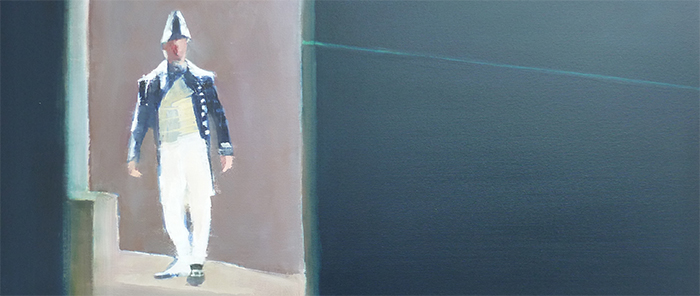
Detail from “It’s a damned paradise”
JON BRADFIELD talks to artist Pippa Blake about her new theatre-inspired exhibition.
Theatre’s a pretty transient art-form – once the last performance is over and the lights go down, it’s over. The cast moves on to other projects, the costumes are sent back and dry-cleaned, and we get on with the business of planning our next tour.
So we’re excited to have an unusual, permanent artistic legacy to one of our recent shows. The painter Pippa Blake joined us in rehearsals last year for our production of Pitcairn, a new play by Richard Bean about the colonizing of a South Pacific island in 1789. Pippa has completed a series of paintings inspired by the piece which are about to go on display (see dates below). Some clearly show their origins in the theatre production, while others seem to take us onto the island itself.
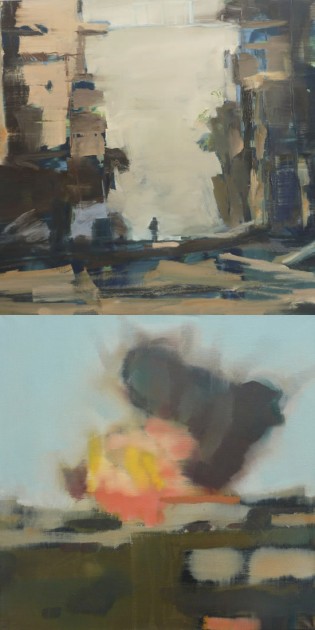
Two paintings by Pippa Blake
Was this the first time you’ve used theatre as a starting point?
I’d never used the theatre as a starting point before but the idea came to me while watching Howard Barker’s play Scenes from an Execution at the National Theatre in 2012. Everything resonated – I’d been making war paintings, and here was a 16th Century female war artist struggling in a male dominated world and wanting to show the truth, not what the bureaucrats wanted her to depict.
How did those war paintings come about? Those scenes of bombed cities and military helicopters, what was your source for them, and what are you trying to do with them?
I have been interested in war since studying the First World War poets at school. Wilfred Owen’s ‘Strange Meeting’ had a profound impact on me – I remember scribbling skeletons on essay papers at the time. I started out a landscape painter, then around ten years ago wanted to be saying more about the world. All the images of the Middle Eastern war on television began to affect me and move me towards making work – as well as the anniversary of Auschwitz in 2005 and the powerful images from 9/11 also. There is something about the soulfulness and loneliness of the bombed street scenes, which resonates with something inside of me, and perhaps I am trying to show that within the work
Your Pitcairn paintings evoke the production but you also spent time in rehearsals.
That was crucial. Although I haven’t used the drawings I made during them it gave me a greater insight into how a play is made and to get to the very bones of how life is breathed into it. It helped me understand what was behind the story of Pitcairn.
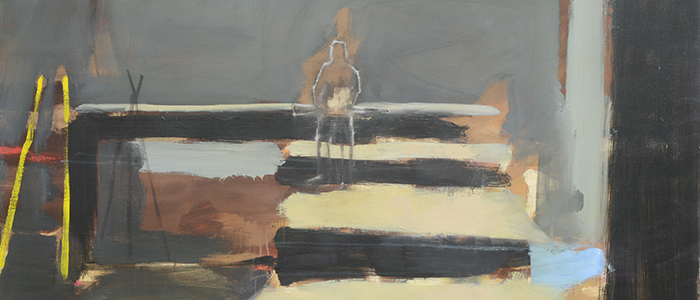
Detail: The Rehearsal
Aside from sketching, how was the experience of watching the play being rehearsed?
Artist or not I found the rehearsals fascinating, listening to Max Stafford-Clark challenging the actors in getting into the character of their parts. I felt it was a privilege to be an onlooker and not only to watch the characters take shape and how they worked with each other but also how the actors reacted with each other personally.
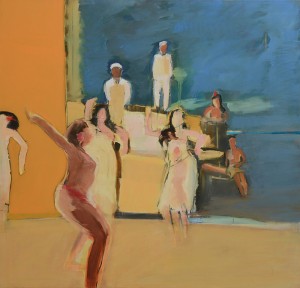
Be strong we are taking control
Are you much of a theatregoer?
I grew up near Chichester Festival Theatre and was taken by my parents early on and there were school visits to Stratford and the Yvonne Arnaud at Guildford. During art school at Camberwell we would get cheap seats to the National. I would call myself a keen theatergoer who doesn’t go often enough.
Some of your paintings have been very abstract, some figurative, some are somewhere between the two. Do you always know when you start painting where you’re going to land between those two extremes?
That is a good question for me as I have been a very abstract painter and never a very figurative painter, at least in terms of realism. And of course the very nature of working with the theatre means that figures come into play. I never know when I begin a work what is going to happen on the canvas. I have an image as a starting point –a photograph or a drawing – and during the process of making the painting I lose the original photographic image, return to it, and then might lose it again. It used to worry me that I had these two apparently different approaches but now rest easy with the fact that I could go either way and perhaps have two styles – look at the work of Gerhard Richter to see how he sits within the two ways of working.
So when do you have an idea of what the finished painting will be?
It’s something I arrive at. Quite often I will completely change the painting and begin a new one on the same surface, which seems to be establishing itself as the way I work. Really I need to have many layers of work on the canvas until I begin finding what it is I am searching for.
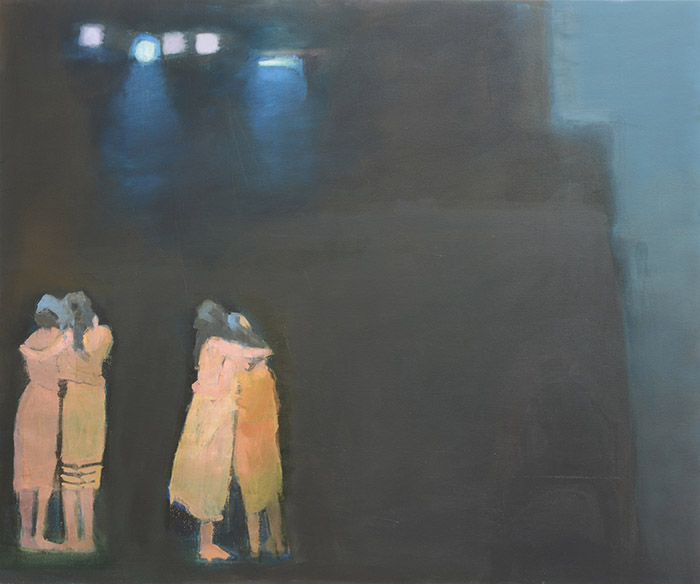
Our sentence a life sentence
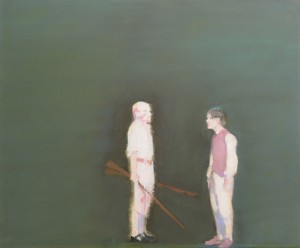
We’re a crop and we have a blight
In one of the Pitcairn paintings there’s a definite suggestion of theatre lighting, and another is called “the rehearsal”, but in most of them there’s no inherent reference to their genesis in a theatre production. So what do you think the paintings are “of”? Are they a recording of actors in 2014 performing a play about people and events on Pitcairn in 1789; or do they somehow bypass the show to become a depiction of the people and events on Pitcairn themselves? To put it another way: Are the clothes in these paintings the costumes from the play, which clearly they resemble; or are they the naval uniforms and Tahitian dress from 1789?
They are certainly the costumes from the play because the paintings could never have emerged without my experience of the play. However I would like to think that I have taken the paintings beyond the visual level of the theatre production in that there is very little direct reference to the stage-set (apologies to designer Tim Shortall!) although I was initially very inspired by the drama of his sets.
What is important is that I get across an emotion or feeling of atmosphere about the bones of the play. I ‘m trying to pare down to the essence of what is going on. I am also well aware of recent goings on in Pitcairn Island and the historical implications of life on the island that I am also mindful of in the work.
Do you generally work in phases, or series? I mean, you generally work on a number of pictures on a theme or style at the same time or in close succession?
Yes – I like to treat the work as a project involving investigation and research, so work on a series of paintings with the same subject matter. I work on several canvases at once – one reason is purely practical in that working in layers with oil paint I need to wait for paint to dry! And I like to be able to imbue the same spirit into all the works. so it is helpful to not stop and start one at a time.
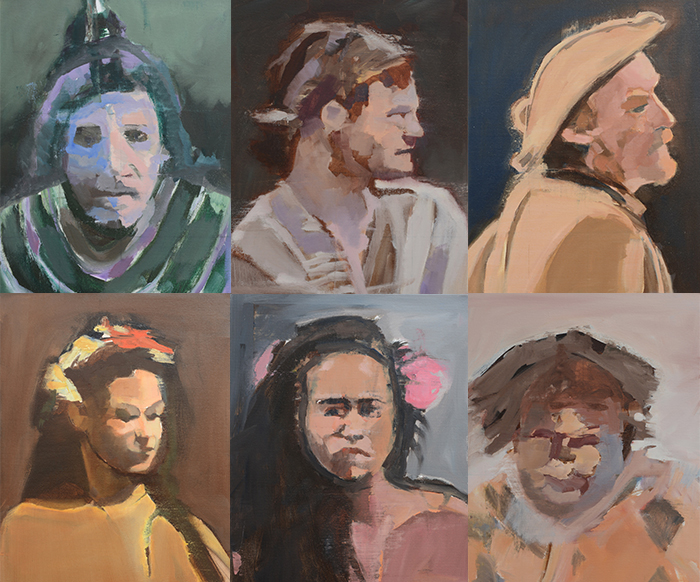
Six paintings of characters from Pitcairn
What artists do you like? Current and historical
I grew up looking at Cezanne, Bonnard, Matisse and then Richard Diebenkorn, Willem de Kooning, Mark Rothko and Philip Guston. Current artists I look at are Anselm Kieffer, Gerhard Richter, Peter Doig, Cai Guo-Qiang, Tacita Dean and Adrian Ghenie amongst others.
Do you buy much art?
I used to buy work from artist friends but not so much these days – artists are not normally in a position to buy much art. When I visit galleries and exhibitions I like to decide which would be the one I would take away with me were it possible.
How do you spend your time when you’re not painting?
I travel a great deal and spend time in New Zealand, which is second home for me. I love walking up hills, watching movies, going to theatre, reading, drinking wine and I love dancing. I also have a small wooden boat, which I love to sail on fair weather days.
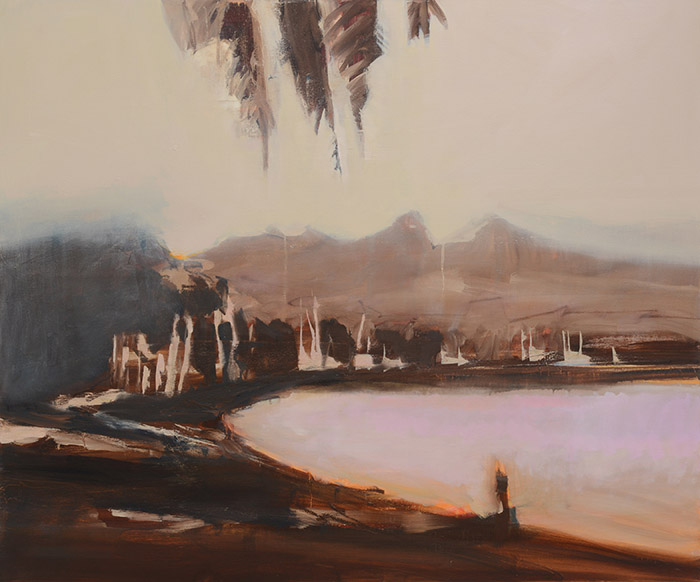
Paradise
You’ve travelled a lot. Best three places/experiences?
I’ve spent time in French Polynesia and love the island of Tara – vanilla plantations, lush and warm. I’ve spent time in the Amazon on an expedition boat, working as an artist with the sense of being surrounded by a vast forest and its remoteness. Likewise sailing across the Indian Ocean, being on the dawn watch as the sun rose and feeling the vastness of the ocean and world around you. A very recent trip to China was fascinating and inspiring to go back to learn more about it’s history and politics.
Has your art been influenced by art you’ve encountered from different culture when you’ve travelled?
No, I don’t feel I’ve been influenced particularly from the art of different cultures although back in the late 70’s going to New York and seeing the Abstract Expressionists first hand had a huge impact on me – particularly Willem de Kooning, Franz Kline and Philip Guston.
See the Pitcairn pictures here:
Pippa Blake | Utopia : Dystopia
26-31 May: Embassy Tea Gallery, 195-205 Union Street, London SE1 0PB
5-17 June: West Dean Collage, Nr Chichester, West Sussex, PO18 0QZ

 Search
Search
